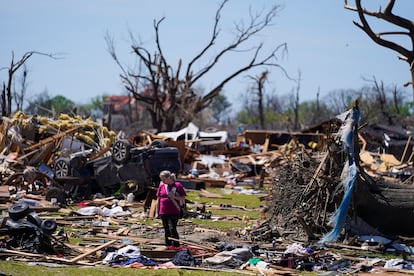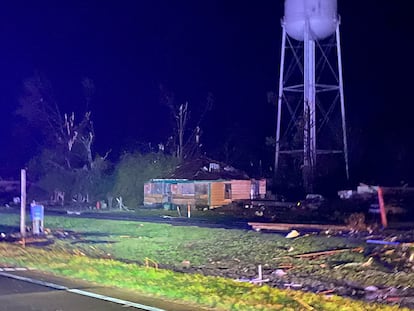Biden visits Mississippi town ravaged by deadly tornado
Last week’s twister destroyed 300 homes and businesses in Rolling Fork, Mississippi, and nearby Silver City, leaving mounds of lumber, bricks and twisted metal

President Joe Biden on Friday is visiting a Mississippi town ravaged by a deadly tornado, even as a new series of severe storms threatens to rip across the Midwest and the South.
Last week’s twister destroyed roughly 300 homes and businesses in Rolling Fork, Mississippi, and the nearby town of Silver City, leaving mounds of lumber, bricks and twisted metal. Hundreds of additional structures were badly damaged. The death toll in Mississippi stands at 21, based on those confirmed by coroners. One person died in Alabama, as well.
Biden was announcing that the federal government will cover the total cost of the state’s emergency measures for the next 30 days, including overtime for first responders and debris cleanup. He’s announcing the Federal Emergency Management Agency will open disaster recovery centers in storm ravaged counties to help residents access the resources available to them.
The president and first lady Jill Biden are to survey the damage, meet with homeowners impacted by the storms and first responders and get an operational briefing from federal and state officials. They’re expected to be joined by Gov. Tate Reeves, Sen. Cindy Hyde-Smith and Rep. Bennie Thompson.
In a statement after the tornado, Biden pledged that the federal government would “do everything we can to help.” “We will be there as long as it takes,” he said. “We will work together to deliver the support you need to recover.”
Presidents regularly visit parts of the U.S. that have been ravaged by natural disasters or suffered major loss of life from shootings or other disasters. Republicans have criticized Biden for not yet making a trip to the site of a toxic chemical spill in a small Ohio town. He also has to decide whether to visit Nashville after three children and three adults were shot and killed at Covenant School.
Last week’s severe weather makes life even more difficult in an area already struggling economically. Mississippi is one of the poorest states, and the majority-Black Delta has long been one of the poorest parts of the state — a place where many people live paycheck to paycheck, often in jobs connected to agriculture.
Two of the counties walloped by the tornado, Sharkey and Humphreys, are among the most sparsely populated in the state, with only a few thousand residents in communities scattered across wide expanses of cotton, corn and soybean fields. Sharkey’s poverty rate is 35%, and Humphreys’ is 33%, compared with about 19% for Mississippi overall and less than 12% for the entire United States.
FEMA administrator Deanne Criswell said some of the damage to the area’s infrastructure will take much time to repair and that the administration will help in rebuilding key facilities to be “more resilient” to withstand future natural disasters.
“We know that these communities could be cash strapped and we want to get that funding flowing,” Criswell added.
Biden approved a disaster declaration for the state, which frees up federal funds for temporary housing, home repairs and loans to cover uninsured property losses. But there’s concern that inflation and economic troubles may blunt the impact of federal assistance.
Biden has spoken in separate phone calls with Reeves, Sen. Roger Wicker, Hyde-Smith and Thompson.
An unusual weather pattern has set in, and meteorologists fear that Friday will be one of the worst days, with much more to come. The National Weather Service said 16.8 million people live in the highest-risk zone, and more than 66 million people overall should be on alert Friday.
According to a new study, the U.S. will see more of these massive storms as the world warms. The storms are likely to strike more frequently in more populous Southern states including Alabama, Mississippi and Tennessee.
The study in the Bulletin of the American Meteorological Society predicts a nationwide 6.6% increase in tornado- and hail-spawning supercell storms and a 25.8% jump in the area and time the strongest storms will strike, under a scenario of moderate levels of future warming by the end of the century.
But in certain areas in the South the increase is much higher. That includes Rolling Fork, where study authors project an increase of one supercell a year by 2100.
Sign up for our weekly newsletter to get more English-language news coverage from EL PAÍS USA Edition
Tu suscripción se está usando en otro dispositivo
¿Quieres añadir otro usuario a tu suscripción?
Si continúas leyendo en este dispositivo, no se podrá leer en el otro.
FlechaTu suscripción se está usando en otro dispositivo y solo puedes acceder a EL PAÍS desde un dispositivo a la vez.
Si quieres compartir tu cuenta, cambia tu suscripción a la modalidad Premium, así podrás añadir otro usuario. Cada uno accederá con su propia cuenta de email, lo que os permitirá personalizar vuestra experiencia en EL PAÍS.
¿Tienes una suscripción de empresa? Accede aquí para contratar más cuentas.
En el caso de no saber quién está usando tu cuenta, te recomendamos cambiar tu contraseña aquí.
Si decides continuar compartiendo tu cuenta, este mensaje se mostrará en tu dispositivo y en el de la otra persona que está usando tu cuenta de forma indefinida, afectando a tu experiencia de lectura. Puedes consultar aquí los términos y condiciones de la suscripción digital.
More information
Archived In
Últimas noticias
Most viewed
- Alain Aspect, Nobel laureate in physics: ‘Einstein was so smart that he would have had to recognize quantum entanglement’
- David King, chemist: ‘There are scientists studying how to cool the planet; nobody should stop these experiments from happening’
- Maps of the US attack on Venezuela: Targets, airspace and deployed fleet
- Key points of the military attack on Venezuela: Early morning bombings and a ‘captured’ president
- Mexico completes its trade shift with the entry into force of tariffs on China and countries without trade agreements










































